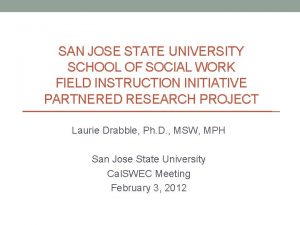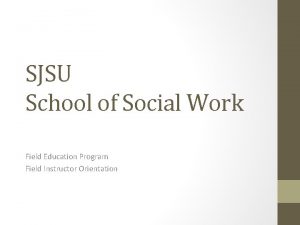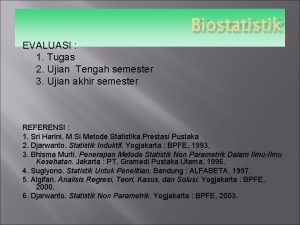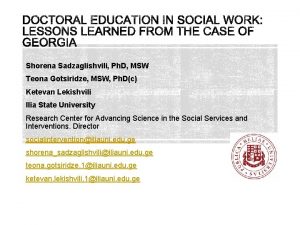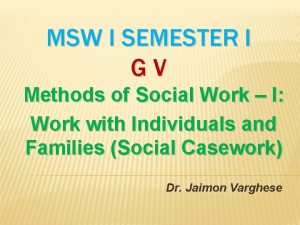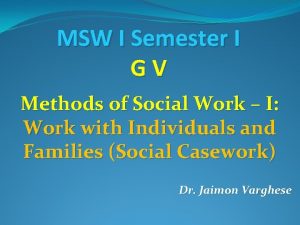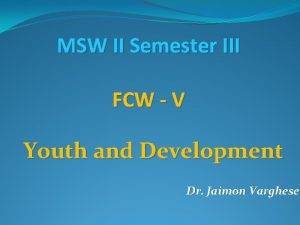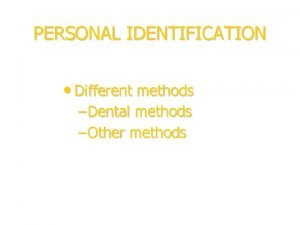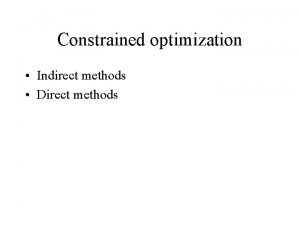MSW I Semester I G 5 Methods of





































- Slides: 37

MSW I Semester I G 5 Methods of Social Work – I: Work with Individuals and Families (Social Casework) Dr. Jaimon Varghese

Unit 2. Principles of Social Casework Practice i. Individualization ii. Purposeful expression of feelings iii. Controlled emotional involvement iv. Acceptance v. Non-judgmental attitude vi. Client self determination vii. Confidentiality 25 -09 -2020 23: 39: 05 Method 1: Social Casework 2

Principle of Social Case Work Principles constitute the rationale for actions. They facilitate fixing standards for right action. 'Principles are rules of action for guiding performance (Grace Mathew, 1992: 9)

Principle of Social Case Work Principles are part of value base for social work profession. Social case work is governed by a set of principles Every social worker should honestly observe them in their social casework practice.

Principle of Social Case Work Violation of any principle in their professional practice amounts to violation of a professional code of conduct

i. Individualization • Individualisation is the recognition and understanding of each client’s unique qualities and the differential use of principles and methods in assisting each toward a better adjustment. 25 -09 -2020 23: 39: 14 Method 1: Social Casework 6

i. Individualization • Individualisation is based upon the right of human beings to be individuals and to be treated not just as a human being but as this human being with his personal differences. 25 -09 -2020 23: 39: 18 Method 1: Social Casework 7

i. Individualization • The role of the caseworker • (1) Freedom from bias and prejudice • (2) Knowledge of human behaviour • (3) Ability to listen and to observe • (4) Ability to move at the client’s pace • (5) Ability to enter into the feelings of people • (6) Ability to keep perspective 25 -09 -2020 23: 39: 27 Method 1: Social Casework 8

i. Individualization • Means of individualising • (1) Thoughtfulness in details • (2) Privacy in interviews • (3) Care in keeping appointments • (4) Preparation for interviews • (5) Engaging the client • (6) Flexibility (Biestek, 1967: 25 -30) 25 -09 -2020 23: 39: 38 Method 1: Social Casework 9

ii. Purposeful expression of feelings • Purposeful expression of feelings is the recognition of the client’s need to express his feelings freely, especially his negative feelings. 25 -09 -2020 23: 39: 40 Method 1: Social Casework 10

ii. Purposeful expression of feelings • The caseworker listens purposefully, neither discouraging nor condemning the expression of these feelings, sometimes even actively stimulating and encouraging them when they are therapeutically useful as a part of the casework service. 25 -09 -2020 23: 39: 45 Method 1: Social Casework 11

ii. Purposeful expression of feelings Purposes: (1) To relieve pressures and tension and thus to help the client see his problems more clearly and objectively (2) To understand more adequately the problem and the person of the client for more accurate study, diagnosis and treatment (3) Listening to a person’s feelings in relation to a problem is a form of psychological support 25 -09 -2020 23: 39: 50 Method 1: Social Casework 12

3. iii. Purposeful expression of feelings • Purposes: • (4) In some cases the negative feeling of the client may be the real problem. An expression of the feelings, then, brings them out into the open so that something can be done about them • (5) To deepen the case work relationship 25 -09 -2020 23: 39: 51 Method 1: Social Casework 13

ii. Purposeful expression of feelings Limitations: (1) Agency function (2) Premature expression of deep feelings can create undesirable and necessary guilt feelings in the client. (3) The expression of feelings denotes a partial and temporarily necessary dependence of the client upon the caseworker, but it should not promote and overdependence 25 -09 -2020 23: 39: 53 Method 1: Social Casework 14

ii. Purposeful expression of feelings • The role of the caseworker: • (1) The function of the caseworker is principally to create an environment in which the client will be comfortable in giving expression to his feelings. The caseworker should be relaxed in order to help the client feel fairly comfortable. 25 -09 -2020 23: 39: 55 Method 1: Social Casework 15

ii. Purposeful expression of feelings • The role of the caseworker: • (2) Good casework requires a certain amount of preparing for each interview, so that the worker will be free to observe to listen thoughtfully and to think, see, and feel with the client. • (3) Ability to listen attentively and purposefully 25 -09 -2020 23: 40: 02 Method 1: Social Casework 16

ii. Purposeful expression of feelings • (4) Encourage the client to express his feelings, by the repetition of words or brief phrases which the client has used; dissecting comments to the feeling tones rather than the facts presented and by letting the client know, perhaps quite directly the people who have strong ambivalent feelings about important persons and things in their environment and that it is all right to express them within the casework relationship. 25 -09 -2020 23: 40: 05 Method 1: Social Casework 17

ii. Purposeful expression of feelings • (5) A sensitive awareness of the clients’ rate of movement, in each interview, towards his casework goals is very necessary. • (6) Unrealistic reassurance, too early interpretation and too much interpretation can block the client’s expression of feelings (Biestek, 1967: 35 -44) 25 -09 -2020 23: 40: 10 Method 1: Social Casework 18

iii. Controlled emotional involvement • The controlled emotional involvement is the caseworker’s sensitivity to the client’s feelings, an understanding of their meaning, and a purposeful, appropriate response to the client’s feelings’ (Biestek, 1967: 50) 25 -09 -2020 23: 40: 11 Method 1: Social Casework 19

iv. Acceptance • Acceptance is a principle of action wherein the caseworker perceives and deals with the client as he really is including his strengths and weaknesses, his congenial and uncongenial qualities, his positive and negative feelings, his constructive and destructive attitudes and behaviour, maintaining all the while, a sense of the client’s innate dignity and personal worth. 25 -09 -2020 23: 40: 12 Method 1: Social Casework 20

iv. Acceptance • Acceptance doesn’t mean approval of deviant attitudes or behaviour. The object of acceptance is not ‘the good’ but ‘the real’. The object of acceptance is pertinent reality. 25 -09 -2020 23: 40: 13 Method 1: Social Casework 21

iv. Acceptance • The purpose of acceptance is therapeutic; to aid the caseworker in understanding the client as he really is, thus making casework more effective; and to help the client free himself from undesirable defences, so that he feels safe to reveal himself and look at himself as he really is and thus to deal with this problem and himself in a more realistic way’ (Biestek, 1967: 72) 25 -09 -2020 23: 40: 15 Method 1: Social Casework 22

iv. Acceptance’ obstacles: • (1) Insufficient knowledge of patterns of human behaviour • (2) Non acceptance of something in self • (3) Imputing to the client one’s own feelings • (4) Biases and prejudices 25 -09 -2020 23: 40: 18 Method 1: Social Casework 23

iv. Acceptance’ obstacles: • (5) Unwarranted reassurances • (6) Confusion between acceptance and approval • (7) Loss of respect for the client • (8) Over identification’ (Biestek, 1967: 82 -87) 25 -09 -2020 23: 40: 19 Method 1: Social Casework 24

v. Non-judgmental attitude • The non-judgemental attitude is a quality of the casework relationship; it is based on a conviction that the casework function excludes assigning guilt or innocence, or degree of client responsibility for causation of the problems or needs, but does include making evaluative judgements about the attitudes, standards, or actions of the client; the attitudes, which involves both thought and feelings elements is transmitted to the client’ (Biestek, 1967: 90) 25 -09 -2020 23: 40: 23 Method 1: Social Casework 25

vi. Client self determination • The principle of client self determination is the practical recognition of the right and need of clients to freedom in making their own choices and decision in the casework process. 25 -09 -2020 23: 40: 28 Method 1: Social Casework 26

vi. Client self determination • Caseworkers have a corresponding duty to respect that right, recognise that need, stimulate and help to activate that potential for self direction by helping the client to see and use the available and appropriate resource of the community and of his own personality. 25 -09 -2020 23: 40: 33 Method 1: Social Casework 27

vi. Client self determination • The client’s right to self determination, however, is limited by the client’s capacity for positive and constructive decision making by the framework of civil and moral law and by the function of the agency 25 -09 -2020 23: 40: 38 Method 1: Social Casework 28

vi. Client self determination • Client freedom • (1) a necessary fundamental right of the client flowing from his essential dignity as a human being; • (2) a necessarily fundamental right of all individuals in a democratic society; • (3) necessary for the effectiveness in casework service and treatment; and • (4) an essential principle in casework philosophy 25 -09 -2020 23: 40 Method 1: Social Casework 29

vi. Client self determination • The role of the caseworker • (1) To help the client see his problem or need clearly and with perspective; • (2) To acquaint the client with the pertinent resources in the community • (3) To introduce stimuli that will activate the client’s own dormant resources • (4) To create a relationship environment in which the client can grow and work out his own problems 25 -09 -2020 23: 40: 43 Method 1: Social Casework 30

vi. Client self determination • Limitations to self-determination • (1) Limitation of the client’s capacity for positive and constructive decision making • (2) Limitations arising from civil law • (3) Limitation arising from the moral law • (4) Limitations arising from the agency function (Biestek, 1967: 110 -118) 25 -09 -2020 23: 40: 46 Method 1: Social Casework 31

vii. Confidentiality • Clients have a right to protection of personal information about themselves in their relationships with a social agency during and following the process of obtaining service, a right which may be superseded in exceptional situation. 25 -09 -2020 23: 40: 47 Method 1: Social Casework 32

vii. Confidentiality • Recognition of this right requires adherence to the following principles: • (1) The client should be used as the primary source of information about himself and information sought from him should be limited to that which is essential to provide service • (2) Within the agency information regarding a client should be revealed only to those persons and to the extent necessary to provide service 25 -09 -2020 23: 40: 54 Method 1: Social Casework 33

vii. Confidentiality • (3) Other agencies and individual should be consulted only with the client’s consent and within the limits of that consent • (4) Only that information should be recorded and those records maintained that tare essential to provide service and the use of records should be determined by agency function and the consent of the client’ (AASW, 1946) 25 -09 -2020 23: 40: 56 Method 1: Social Casework 34

Recommended Readings: 1. Mathew Grace (1992) An Introduction to Social Case Work, Bombay: Tata Institute of Social Sciences 2. Perlman, Helen Harris (1957) Social Case Work – A Problem Solving Process, Chicago: University of Chicago Press (Indian reprint, 2011, Jaipur: Rawat Publications) 3. Nursten, Jean (1974) Process of Case Work, Pitman Publishing Corporation 3. Timms, Noel (1966) Social Case Work, London: Routledge & Kegan Paul 5. Upadhyay, R. K. (2003) Social Case Work, Jaipur & New Delhi: Rawat Publications 25 -09 -2020 23: 40: 58 Method 1: Social Casework 35

Recommended Readings: 6. Biestek FD (1967) The Casework Relationship, London: Unwin University Books 7. Lawrence M Brammer (1985) The Helping Relationship: process and skills, Englewood Cliffs, New Jersey: Prentice Hall Inc (3 rd Ed. ) 8. Richmond, Mary (1970) Social Diagnosis, New York: Free Press 9. Gordon Hamilton (1951) Theory and Practice of Social Casework, 2 nd Rev. Ed. , New York: Columbia University Press 10. Prajakata Taksale, ‘Vyakti Sahay Karya’ 25 -09 -2020 23: 41: 10 Method 1: Social Casework 36

Thank You 25 -09 -2020 23: 41: 11 Method 1: Social Casework 37
 Inlay wax pattern fabrication
Inlay wax pattern fabrication Csu google drive
Csu google drive Tk20 uwf
Tk20 uwf Csumb
Csumb Msw vtmis
Msw vtmis Ucsf warn me
Ucsf warn me Msw games
Msw games Logo computer language
Logo computer language Logo programski jezik
Logo programski jezik Wmu msw application
Wmu msw application University of texas at arlington school of social work
University of texas at arlington school of social work University of memphis msw
University of memphis msw Msw apes
Msw apes A flat fee pricing system for msw services
A flat fee pricing system for msw services Kako nacrtati jednakokračni pravokutni trokut
Kako nacrtati jednakokračni pravokutni trokut Aurora university msw
Aurora university msw Aurora university msw
Aurora university msw Csu stanislaus msw
Csu stanislaus msw Hendrefoelan student village
Hendrefoelan student village Msw scholarships 2019
Msw scholarships 2019 Msw
Msw San jose state school of social work
San jose state school of social work Edall button in msw logo
Edall button in msw logo Aka.msw
Aka.msw Fau msw program
Fau msw program F=msb/msw
F=msb/msw Msw el callado
Msw el callado Sjsu msw program
Sjsu msw program Montemarta
Montemarta Salem state msw
Salem state msw Salem state social work
Salem state social work Tourniquet nomenclature
Tourniquet nomenclature Pedoman penilaian sma
Pedoman penilaian sma Kompetensi dasar fisika kelas 11
Kompetensi dasar fisika kelas 11 Kompetensi dasar ipa kelas 8 semester 2
Kompetensi dasar ipa kelas 8 semester 2 Activity 3 identifying expressions kelas 11
Activity 3 identifying expressions kelas 11 Materi sosiologi kelas 12 semester 2
Materi sosiologi kelas 12 semester 2 Pengertian ujian tengah semester
Pengertian ujian tengah semester





















